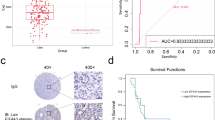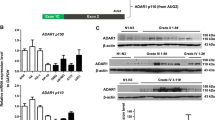Abstract
Eukaryotic initiation factors 3 (EIF3) complex is essential for initiation of protein synthesis for both cells and virus. It consists of 13 subunits (EIF3A to M), among which EIF3B serves as a major scaffolding subunit. However, its functions in human glioblastoma have not been explored yet. Here, we showed that EIF3B was expressed in human glioblastoma (Grade I–IV) and human glioblastoma cell lines (U251, U87, A172 and U373). Loss of function analysis was performed on U87 cells using lentivirus-mediated siRNA against EIF3B. EIF3B-shRNA expressing lentivirus could effectively infect U87 glioma cells and downregulate EIF3B expression. Knockdown of EIF3B expression significantly inhibited proliferation of U87 cells. Further study showed that the proliferation inhibitory effect was associated with accumulation in G0/G1-phase cell number and an increased rate of apoptosis. In conclusion, EIF3B promotes the proliferation of U87 cells and may play an important role in human glioblastoma development.




Similar content being viewed by others
References
Haque A, Banik NL, Ray SK (2007) Emerging role of combination of all-trans retinoic acid and interferon-gamma as chemoimmunotherapy in the management of human glioblastoma. Neurochem Res 32:2203–2209
Pulkkanen KJ, Yla-Herttuala S (2005) Gene therapy for malignant glioma: current clinical status. Mol Ther 12:585–598
Pestova TV, Kolupaeva VG, Lomakin IB, Pilipenko EV, Shatsky IN, Agol VI et al (2001) Molecular mechanisms of translation initiation in eukaryotes. Proc Natl Acad Sci USA 98:7029–7036
Mayeur GL, Fraser CS, Peiretti F, Block KL, Hershey JW (2003) Characterization of eIF3k: a newly discovered subunit of mammalian translation initiation factor elF3. Eur J Biochem 270:4133–4139
Fraser CS, Lee JY, Mayeur GL, Bushell M, Doudna JA, Hershey JW (2004) The j-subunit of human translation initiation factor eIF3 is required for the stable binding of eIF3 and its subcomplexes to 40S ribosomal subunits in vitro. J Biol Chem 279:8946–8956
Zhou M, Sandercock AM, Fraser CS, Ridlova G, Stephens E, Schenauer MR et al (2008) Mass spectrometry reveals modularity and a complete subunit interaction map of the eukaryotic translation factor eIF3. Proc Natl Acad Sci USA 105:18139–18144
Méthot N, Rom E, Olsen H, Sonenberg N (1997) The human homologue of the yeast Prt1 protein is an integral part of the eukaryotic initiation factor 3 complex and interacts with p170. J Biol Chem 272:1110–1116
ElAntak L, Tzakos AG, Locker N, Lukavsky PJ (2007) Structure of eIF3b RNA recognition motif and its interaction with eIF3j: structural insights into the recruitment of eIF3b to the 40S ribosomal subunit. J Biol Chem 282:8165–8174
Nakano I, Saya H (2010) Cancer stem cells in malignant glioma: the mechanism of cancer initiation and the therapeutic development. No Shinkei Geka 38:879–889
Melmed S (2006) Medical progress: Acromegaly. N Engl J Med 355:2558–2573
Hinnebusch AG (2006) eIF3: a versatile scaffold for translation initiation complexes. Trends Biochem Sci 31:553–562
Jackson RJ, Kaminski A (1995) Internal initiation of translation in eukaryotes: the picornavirus paradigm and beyond. RNA 1:985–1000
Pérard J, Rasia R, Medenbach J, Ayala I, Boisbouvier J, Drouet E et al (2009) Human initiation factor eIF3 subunit b interacts with HCV IRES RNA through its N-terminal RNA recognition motif. FEBS Lett 583:70–74
Kastan MB, Bartek J (2004) Cell-cycle checkpoints and cancer. Nature 432:316–323
Author information
Authors and Affiliations
Corresponding author
Rights and permissions
About this article
Cite this article
Liang, H., Ding, X., Zhou, C. et al. Knockdown of eukaryotic translation initiation factors 3B (EIF3B) inhibits proliferation and promotes apoptosis in glioblastoma cells. Neurol Sci 33, 1057–1062 (2012). https://doi.org/10.1007/s10072-011-0894-8
Received:
Accepted:
Published:
Issue Date:
DOI: https://doi.org/10.1007/s10072-011-0894-8




